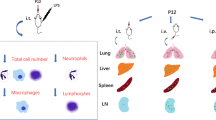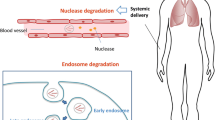Abstract
Purpose. To evaluate the pulmonary distribution of CGP69846A (ISIS 5132), a phosphorothioate oligonucleotide, following intra-tracheal (i.t.) instillation into Brown-Norway rats.
Methods. The pharmacokinetic profile of [3H]-CGP69846A was investigated following i.t. instillation into both naïve and inflamed airways of Brown-Norway rats. The cellular distribution was determined using autoradiography, immunohistochemistry and flow cytometry/fluorescence microscopy, in inflamed airways.
Results. CGP69846A displayed a dose-dependent lung retention following i.t. administration which was unaffected by local inflammation. Autoradiography and immunohistochemistry showed distribution to alveolar macrophages, eosinophils, bronchial and tracheal epithelium and alveolar cells. Studies with [FITCJ-CGP69846A demonstrated a preferential association of oligonucleotide with leukocytes in bronchial lavage fluid of: macrophages > eosinophils = neutrophils > > lymphocytes.
Conclusions. The dose-dependency of lung retention together with cell-specific uptake suggests that the lung can be used as a local target for antisense molecules with potentially minimal systemic effects. Furthermore, the preferential targeting of macrophages and the airway epithelium by oligonucleotides may represent rational cellular targets for antisense therapeutics.
Similar content being viewed by others
REFERENCES
F. A. Dorr and D. L. Kisner. Antisense Oligonucleotides to protein kinase C-α and C-raf kinase: Rationale and clinical experience in patients with solid tumors. In S. T. Crooke (eds.), Antisense Research and Application, Springer, Heidelberg, 1998, pp. 463–476.
S. L. Hutcherson. Clinical antiviral activities. In S. T. Crooke (eds.), Antisense Research and Application, Springer, Hiedelberg, 1998, pp. 445–462.
W. R. Shanahan Jr. Properties of ISIS 2302, an inhibitor of intercellular adhesion molecule-1, in humans. In S. T. Crooke (eds.), Antisense Research and Application, Springer, Heidelberg, 1998, pp. 499–524.
S. Wu-Pong and P. R. Byron. Airway-to-biophase transfer of inhaled oligonucleotides. Adv. Drug Del. Rev. 19:47–71 (1996).
J. W. Nyce. Respirable antisense oligonucleotides as novel therapeutic agents for asthma and other pulmonary diseases. Exp. Opin. Invest. Drugs. 6:1149–1156 (1997).
B. R. Yacyshyn, M. B. Bowenyacyshyn, L. Jewell, J. A. Tami, C. F. Bennett, D. L. Kisner, and W. R. Shanahan Jr. A placebo-controlled trial of ICAM-1 antisense oligonucleotide in the treatment of Crohns-Disease. Gastroenterology 114:1133–1142 (1998).
S. T. Crooke, M. J. Graham, J. E. Zuckerman, D. Brooks, B. S. Conklin, L. L. Cummins, M. J. Greig, C. J. Guinosso, D. Kornbrust, M. Manoharan, H. M. Sasmor, T. Schleich, K. L. Tivel, and R. H. Griffey. Pharmacokinetic properties of several novel oligonucleotide analogs in mice. J. Pharmacol. Exp. Ther. 277:923–937 (1996).
J. A. Phillips, S. J. Craig, D. Bayley, R. A. Christian, R. Geary, and P. L. Nicklin. Pharmacokinetics, metabolism, and elimination of a 20-mer phosphorothioate oligodeoxynucleotide (CGP 69846A) after intravenous and subcutaneous administration. Biochem. Pharmacol. 54:657–668 (1997).
J. W. Nyce and W. J. Metzger. DNA antisense therapy for asthma in an animal model. Nature 385:721–725 (1997).
B. P. Monia, P. Martin, and K-H. Altmann. Antisense oligonucleotide modulation of raf gene expression. WO 96-US8165 960531(US 95-463912 950605).
M. J. Graham, S. M. Freier, R. M. Crooke, D. J. Ecker, R. N. Maslova, and E. A. Lesnik. Tritium labeling of antisense oligonucleotides by exchange with tritiated water. Nucleic Acids Res. 21:3737–3743 (1993).
J. M. Leeds, M. J. Graham, L. Truong, and L. Cummins. Quantification of phosphorothioate oligonucleotides in human plasma. Anal. Biochem. 235:36–43 (1996).
M. Butler, K. Stecker, and C. F. Bennett. Cellular distribution of phosphorothioate oligodeoxynucleotides in normal rodent tissues. Lab Invest. 77:379–388 (1997).
P. L. Nicklin, D. Bayley, J. Giddings, S. J. Craig, L. Cummins, J. G. Hastewell, and J. A. Phillips. Pulmonary bioavailability of a phosphorothioate oligonucleotide (CGP 64128A): Comparison with other delivery routes. Pharm. Res. 15:583–591 (1998).
A. Steward, K. O. Hamilton, and P. L. Nicklin. Co-administration of polyanions with a phosphorothioate oligodeoxynucleotide (CGP 69846A): a role for the scavenger receptor in its in vivo disposition. Biochem. Pharmacol. 56:509–516 (1998).
L. Kobzik. Lung macrophage uptake of unopsonized environmental particulates. Role of scavenger-type receptors. J.Immunol. 155:367–376 (1995).
B. Stringer, A. Imrich, and L. Kobzik. Lung epithelial cell (A549) interaction with unopsonized environmental particulates: quantitation of particle-specific binding and IL-8 production. Exp. Lung Res. 22:495–508 (1996).
R. E. Pitas. Expression of the acetyl low density lipoprotein receptor by rabbit fibroblasts and smooth muscle cells. Up-regulation by phorbol esters. J. Biol. Chem. 265:12722–12727 (1990).
R. E. Pitas, J. Boyles, R. W. Mahley, and D. M. Bissell. Uptake of chemically modified low density lipoproteins in vivo is mediated by specific endothelial cells. J.Cell Biol. 100:103–117 (1985).
G. Hartmann, A. Krug, A. Eigler, J. Moeller, J. Murphy, R. Albrecht, and S. Endres. Specific suppression of human tumor necrosis factor-alpha synthesis by antisense oligodeoxynucleotides. Antisense Nucleic Acid Drug Dev. 6:291–299 (1996).
Y. Rojanasakul, W. Liang, and J. K. H. Ma. Targeted delivery of antisense oligonucleotides for selective inhibition of pulmonary fibrotic cytokines. Resp. Drug Del. 5:55–62 (1996).
G. Hartmann, A. Krug, M. Bidlingmaier, U. Hacker, A. Eigler, R. Albrecht, C. Strasburger, and S. Endres. Spontaneous and cationic lipid-mediated uptake of antisense oligonucleotides in human monocytes and lymphocytes. J. Pharmacol. Exp. Ther. 285:920–928 (1998).
M. F. Taylor, D. D. Weller, and L. Kobzik. Effect of TNF-alpha antisense oligomers on cytokine production by primary murine alveolar macrophages. Antisense. Nucleic. Acid. Drug Dev. 8:199–205 (1998).
Author information
Authors and Affiliations
Rights and permissions
About this article
Cite this article
Danahay, H., Giddings, J., Christian, R.A. et al. Distribution of a 20-Mer Phosphorothioate Oligonucleotide, CGP69846A (ISIS 5132), into Airway Leukocytes and Epithelial Cells Following Intratracheal Delivery to Brown-Norway Rats. Pharm Res 16, 1542–1549 (1999). https://doi.org/10.1023/A:1015048419558
Issue Date:
DOI: https://doi.org/10.1023/A:1015048419558




